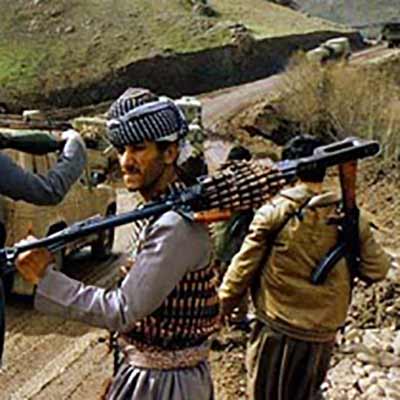Battles
Operation Nasr 7
Azam Sadat Hussaini
204 Views
In August 1987, the Islamic Revolutionary Guard Corps (IRGC) Ground Forces launched Operation Nasr 7 to neutralize the whole area of Sardasht from enemy observation and fire, bring the Iraqi town of Qalah Dizeh under Iranian observation and fire, and control the movements of anti-revolutionary forces.[1]
During the summer of 1987 which coincided with the limited clashes between Iran and the United States in the Persian Gulf, the IRGC Ground and Naval Forces were engaged separately in two different fronts. The IRGC Navy commanded naval warfare, while the Ground Forces actively operated on both southern and northern fronts. During this period, operations Nasr 4, Nasr 5, and Nasr 7 were carried out on the northern front.[2]
The Iraqi forces had been positioned on Sardasht mountains especially Dupaza Heights to facilitate the movement of anti-revolutionary elements and protect them. In response, the IRGC, under the command of Rahim Safavi, the Deputy Commander of the IRGC Ground Forces, planned Operation Nasr 7. The operation began at 2:30 AM on August 5, 1987, with the code-name “Ya Fatimah al-Zahra (s)”.[3]
Iranian forces captured the strategically important Dupaza Heights and part of the Buleft Mountains in two phases.[4]
Before the ground engagement began, the Iranian artillery units heavily bombarded the Iraqi positions and rear lines, after which Iranian commandos attacked the enemy trenches. Operating on the right flank of the area, the 31st Ashura Division made remarkable advances before dawn but was initially unable to join the 27th Muhammad Rasulullah (pbuh) Division. However, later on, when the Ammar Battalion advanced towards the 31st Division positions the two units joined at around 4:00 AM, though by sunrise, the 31st Division had not yet achieved all its designated objectives.
Meanwhile, the 27th Muhammad Rasulullah (pbuh) Division managed to capture the main peak by 4:00 AM and linked up with the Ashura Division, but it failed to seize one of the Iraqi command posts located behind the main Dupaza Peak. On the left side of the front lines, the 18th al-Ghadir Brigade successfully achieved its objectives and maintained its positions. As daylight broke, the 31st Ashura Division, guided by the commander of the Quds Command Post, constructed a road and deployed a tank to target Iraqi bunkers. By 8:20 AM, the division had secured the remainder of its objectives.[5]
In the first phase of Operation Nasr 7, Iran aimed to capture the strategic Dupaza Heights and its ridgelines, Shah Moradi Hill, and the ridge of Buleft Heights (Iranian side). The second phase aimed to seize the Buleft Heights located in Iraqi territory. Due to the importance of the first phase, the 31st Ashura Division, the 27th Muhammad Rasulullah (pbuh) Division, and the 18th al-Ghadir Brigade were tasked with achieving the phase-one objectives. The 29th Nabi Akram (pbuh) Brigade was designated for the second phase.[6]
Dupaza, standing at 2791 meters, is the highest peak in the area. It lies along the Dupaza mountain range, 13 kilometers west of Sardasht, and is located on the border strip.[7]
Recognizing the strategic significance of the area, the Iraqi forces launched heavy counterattacks over ten consecutive days and nights in an attempt to reclaim the captured areas, but they were unsuccessful.[8]
The operation resulted in the liberation of an area measuring 30 square kilometers including the Bulfet border outposts, the Sardasht–Qalah Dizeh asphalt road, the Dupaza Heights (2379 and 2034) and Bulfet (2144 and 2130). Furthermore, during this operation, 10000 Iraqi troops were killed or wounded, and 285 were taken prisoners. In addition, 4 helicopters, dozens of mortars, 10 tanks and armored vehicles, 50 vehicles, and large quantities of light and semi-heavy weapons were destroyed. The Iraqi units destroyed in this operation included the 97th Infantry Brigade, two commando battalions of the 23rd Division, two battalions of the 18th Brigade, one battalion of the 24th Division, and two battalions of the National Defense Forces.[9]
[1] Dorudian, Muhammad, Seyri dar Jang-e Iran va Araq, vol. 4: Shalamcheh ta Halabcheh (A Survey of the Iran-Iraq War, Vol. 4: From Shalamcheh to Halabcheh), Tehran: Markaz-e Motaleat va Tahqiqat-e Jang, 1997, p. 194.
[2] Rashid, Mohsen, Atlas-e Jang-e Iran va Araq (Atlas of the Iran-Iraq War), Tehran: Markaz-e Motaleat va Tahqiqat-e Jang, 2nd ed., 2010, p. 95.
[3] Yazdanfam, Mahmoud, Ruzshomar-e Jang-e Iran va Araq, Ketab-e Panjahom: Escort-e Naftkesh-ha (Chronology of the Iran-Iraq War, Vol. 50: Escorting Oil Tankers), Tehran: Markaz-e Motaleat va Tahqiqat-e Jang-e Sepah, 1999, p. 214.
[4] Ibid., Pp. 215–216.
[5] Yazdanfam, Mahmoud, Ruzshomar-e Jang-e Iran va Araq, Ketab-e Panjahom (Chronology of the Iran-Iraq War, Vol. 50), p. 214.
[6] Dorudian, Muhammad, Seyri dar Jang-e Iran va Araq, vol. 4 (A Survey of the Iran-Iraq War, Vol. 4), Pp. 194, 196.
[7] Ibid., p. 194.
[8] Ibid., p. 196.
[9] Samiei, Ali, Karnama-ye Amaliat-e Razmandegan-e Islam dar Toul-e Hasht Sal Defa-e Muqaddas (The Record of Islamic Combatants' Operations during the Eight Years of Sacred Defense), Tehran: Namayandegi-ye Vali-ye Faqih dar Niro-ye Zamini, Moavenat-e Entesharat, Modiriyat-e Nashr, 1997, Pp. 351–352.





